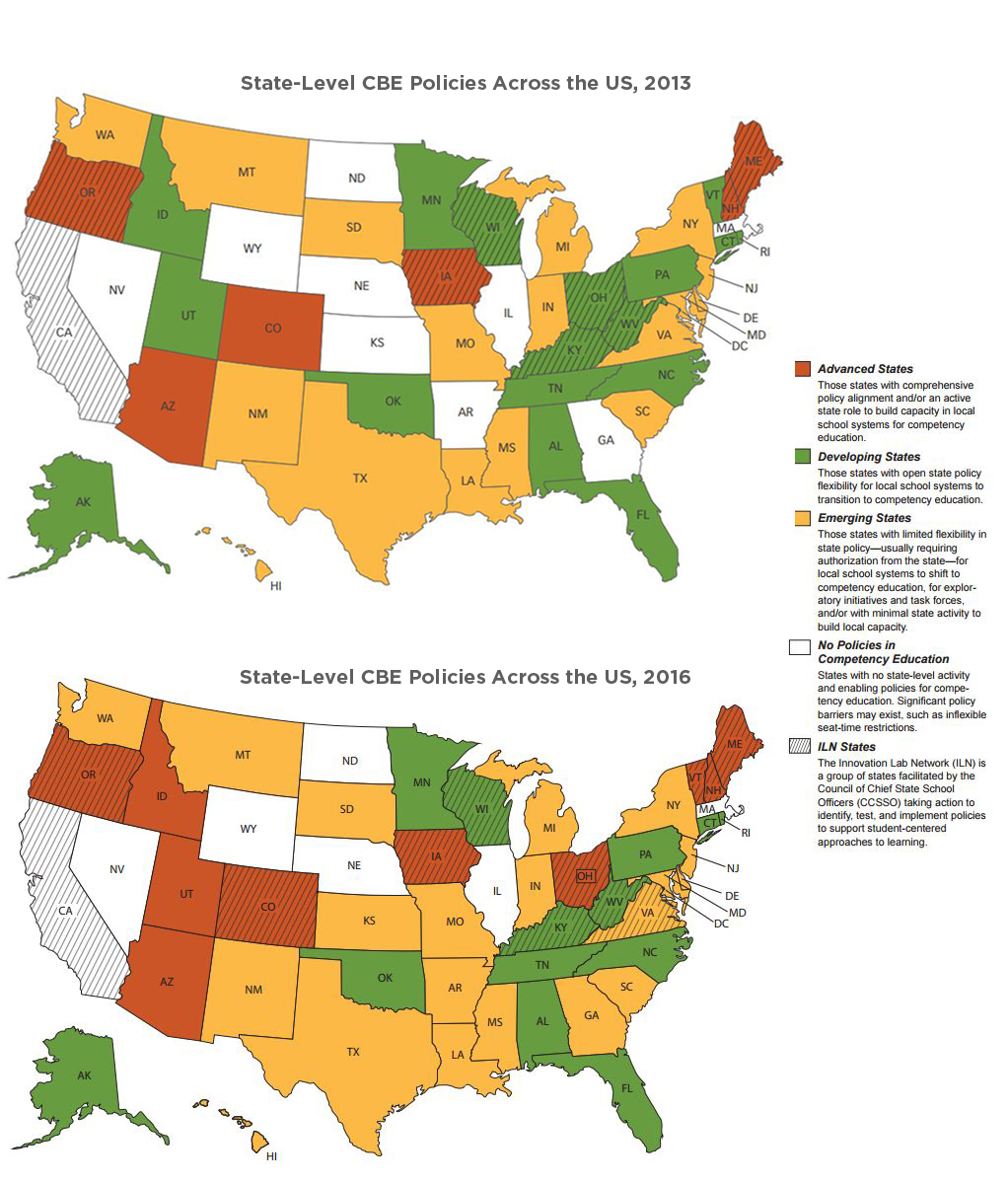Grit. Open. Disruptive innovation. Powerful ideas that seem simple in print quickly take on new, and potentially divergent, meanings as they are applied to policy and practice. Some terms, including “open,” get appended to specific use cases. Others become “bastardized,” in the words of Clayton Christensen, who coined “disruptive innovation.”
Enter competency-based learning (CBE), a term introduced in the 1970s when the U.S. Department of Education issued grants to support CBE programs, focused on helping adult learners, at postsecondary institutions. Since then, CBE has trickled down into the K-12 system, where enthusiasm and support have led to statewide policies supporting the development of such programs in regions like New England.
Yet not everyone agrees on what CBE means—or how it should be implemented in K-12. “It’s still too early to say, ‘this is what it should look like,’” says Scott Ellis, CEO of MasteryTrack. “We’re still trying to figure this out. I think there are opportunities to standardize different approaches and how we get to the end goal.”
What most agree on
This is the standard definition of competency-based education that most educators, policymakers and researchers largely agree with: a system in which students progress based on their demonstration of mastery of a certain concept or skill. Even more may nod their heads on what CBE is not—a time-based system where learners progress regardless of whether or not they’ve mastered the prerequisite materials. (Why, for instance, should we expect students to tackle fractions if they struggled with basic arithmetic operations?)
“One of the virtues of a CBE system is that we’re not going to tolerate a lack of mastery or gaps of learning,” says Julia Freeland Fisher, Director of Education at the Clayton Christensen Institute.
Yet that’s where the agreement ends. In practice, competency-based education resembles the thousand-flower garden. “CBE is a philosophy, not a single intervention or practice,” Fisher adds. “There are some unsexy barriers to making it work logistically on the ground.”
Is it all about pacing?
One of the more hotly contested misconceptions about a competency-based education is the emphasis on pacing, or the idea that students each progress at their own speed. A common refrain used to describe the CBE approach is: “Learning is the constant, and time is the variable.”
But not everyone agrees that pacing is the central principle around which CBE models should be organized. Karla Phillips, Policy Director for Competency Based Education at the Foundation for Excellence in Education, wants to make clear that there is a fine-grained but important nuance between “go at your own pace” and “flexible pacing.” It’s not acceptable, for instance, to let a student take two years to master multiplication. The core promise of CBE, she says, is to create a system where teachers can provide the instructional support meet all students’ needs, regardless of where they are at.
“The goal of CBE is student success, and flexible pacing is just one small feature of the system that leads to that,” says Chris Sturgis, founder of MetisNet. “It’s not about time, it’s about giving students more instructional support. Having more time isn’t going to change much if schools haven’t thought about how to do this.”
Focusing just on pacing also raises equity concerns, especially for learners who lag behind their peers. “There are a lot of concern around issues of equity if there isn’t a minimum pace at which students progress,” says Michael Horn, a principal consultant at Entangled Solutions. “How are teachers going to put more effort to help those who are lagging so that they don’t fall behind?”
End-of-year state testing can be useful as a “gut check,” says Phillips, to ensure that students don’t fall too behind. Yet preparing students to take them may dis-incentivize teachers from helping students acquire a wider range of skills and knowledge, says Sturgis. “Is it fair to only cover the standards that are going to be on the test?”
What does ‘mastery’ look like?
How one demonstrates “mastery” may vary according to the subject or skill in question. Figuring out which assessments that are appropriate for each competency takes work. Certain low-level yet fundamental concepts, such as single-digit multiplication, can be demonstrated through conventional assessments, such as multiple-choice questions. Other objectives may be more suitable for performance- or project-based assessments that are evaluated with subjective rubrics. Demonstrating understanding of a novel, for instance, may require an oral report or online presentation.
Assessments also raise another bucket of questions: Is “mastery” a binary result, a simple yes/no in terms of whether one has fully mastered the material? Or should there be gradations—similar to how letter grades equate to a certain percentage of mastery (where an A typically represents 90 percent or more comprehension, a B means at least 80 percent, and so on)?
There is also debate over what a student should tackle next after mastering a concept. Keeping with the multiplication example, traditionally learners tackle division afterward. Yet others see an opportunity for “deeper” learning; perhaps the student should tackle double- or triple-digit multiplication next.
One can imagine the headaches if every CBE school or district were to create its own rubric for assessing mastery. “I personally think that there needs to be a way to make comparisons across schools and districts,” says Horn.
How effective are policy levers?
There are glimpses of unified CBE efforts at the state level. In 2005, New Hampshire became the first state in the country to tie high school graduation requirements to demonstration of competencies in core subject areas. A decade later, the state piloted a set of performance-based competency assessments in six districts.

Other states have begun to change rules to allow schools more flexibility in experimenting with CBE approaches. Idaho, for instance, offers waivers from the traditional “seat time” requirement—which is often tied to funding. Instead, schools and districts can report how many students are hitting particular goals in a certain amount of time—rather than how many days they have physically attended school.
Yet there are limitations to how much impact can be made through state mandates. With all the outstanding questions around its implementation, mandating CBE as a policy from the top is unlikely to be effective. “State policies can enable, incentivize and create conditions for innovations,” says Phillips, who advises state education officials in her role. But what CBE implementation looks like in each school or district “is ultimately a local decision.” A smarter approach, she says, would be for state officials to ask educators: “What areas of flexibility do you really need?”
“We’re at moment where we need to understand effective practice before we put it on the policy scale,” says Fisher.
What role does technology play?
Personalized learning technology seems primed to support CBE models, by allowing students in the same room to work through different content based on their varying skill levels and needs. These tools also allow students to master content at a flexible place, and keep track of the skills and knowledge areas in which they are succeeding or struggling. “Technology is of tremendous benefit of helping us do CBE at scale,” says Horn.
It would be a mistake, however, to consider technology as the main instructional delivery vehicle in a CBE system, warns Sturgis. Even more troublesome is the notion of conflating CBE with online learning. It’s misleading “for a software to say it is competency-based,” she says, since the term encompasses “a new structure for a school or district, not simply how you deliver instruction.” Software cannot enable a CBE model by itself.
According to the CompetencyWorks website: “Digital tools to personalize instruction should be used appropriately based on the overall pedagogical philosophy of the school and the needs of the students. A classroom cannot be deemed competency-based or personalized simply because students are learning with digital content, are using adaptive software, or have flexible pacing.”
Coda
“When we say CBE, we’re typically refer to three different things,” says Fisher: philosophy, policy and practice. There are debates within each of those lenses—and aligning all three may well be impossible.
Despite the unresolved questions, momentum for CBE is growing. Sturgis estimates that roughly 10 percent of all U.S. districts have begun implementing, or are actively investigating, CBE models. “We have innovative models developing that suggest how we might free up the design of schools to focus on learning. We are confident that districts can make this change to competency-based education.”


